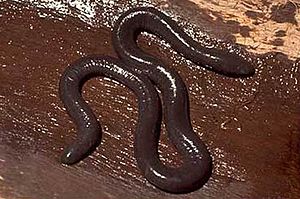Chthonerpeton indistinctum facts for kids
Quick facts for kids Chthonerpeton indistinctum |
|
|---|---|
 |
|
| Conservation status | |
| Scientific classification | |
| Genus: |
Chthonerpeton
|
| Species: |
indistinctum
|
| Synonyms | |
|
Siphonops indistinctus Reinhardt and Lütken, 1862 "1861" |
|
The Chthonerpeton indistinctum is a type of caecilian. Caecilians are amphibians that look a lot like snakes or worms. This specific species belongs to the Typhlonectidae family. You can find it in parts of Argentina, Paraguay, Uruguay, and Brazil. People often call it the Argentine caecilian.
Contents
What is the Argentine Caecilian Like?
The Argentine caecilian is an amphibian that looks like a snake. It does not have any legs. It can grow to be about 53 centimeters (21 inches) long.
Body Features
Its body has 70 to 80 folds that go across it. These folds make it look like it has segments or rings. On its head, it has two special feelers, called tentacles. These feelers are located between its nostrils and eyes. The skin around these feelers is white.
Color and Markings
The top of its body is black. The underside is dark grey. Both sides have tiny white dots. The flat, round area around its cloaca (which is like a vent for waste and reproduction) is a creamy white color.
Where Does the Argentine Caecilian Live?
You can find C. indistinctum in Paraguay, Uruguay, Brazil, and Argentina. It lives in places that are up to 1,000 meters (3,300 feet) high.
Habitat and Movement
This caecilian spends some time on land and some time in water. It might even travel between these places each year. When it is on land, it usually stays close to river banks. But sometimes, it will go a bit further away from the water.
Surviving in Different Waters
Sometimes, these caecilians get carried out to sea on floating plants. They have even been found alive in the brackish water of estuaries. Brackish water is a mix of fresh and salty water. This species is quite common. Sometimes, you can find many of them together. The IUCN Red List of Threatened Species says it is of "Least Concern". This means it is not currently in danger of disappearing.
How Does the Argentine Caecilian Reproduce?
This species is viviparous. This means that the mother gives birth to live young. They do not lay eggs that hatch outside her body.
Understanding Caecilian Evolution
Scientists study the Argentine caecilian to learn more about how caecilians have changed over time. They look at things like their chromosomes. Chromosomes are tiny structures inside cells that carry genetic information. By studying these, scientists hope to understand how different caecilian species are related to each other.
See also
 In Spanish: Chthonerpeton indistinctum para niños
In Spanish: Chthonerpeton indistinctum para niños


